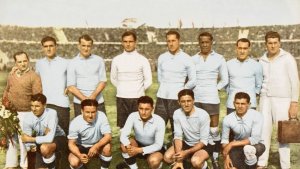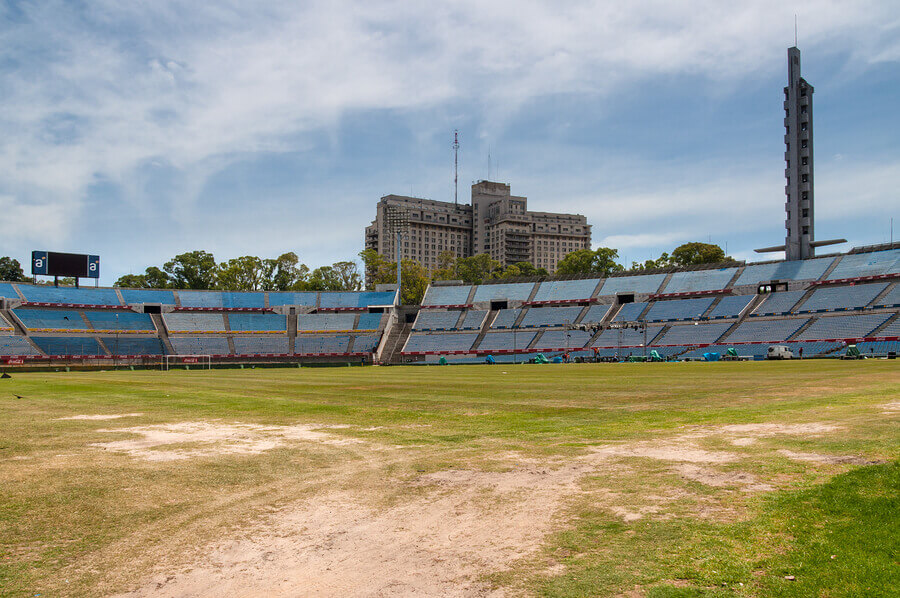Uruguay, The First World Cup Champion

Since the International Federation of Association Football (FIFA) was founded in 1904, soccer-playing countries wanted to organize a tournament to bring each country together. During the first years after FIFA was founded, the entity didn’t have the infrastructure to carry out such a tournament. It was more than two decades later that the first World Cup in Uruguay took place.
A meeting, held in Amsterdam in 1928, decided the championship venue. The congress selected Uruguay, a small South American country that already had some soccer experience. They also had the right budget for the construction of special stadiums for the championships. The congress also decided that the tournament would take place between the 13th and 30th of July, 1930.
Participants and stadiums of the first World Cup in Uruguay
There were 13 countries that participated in the first World Cup and they were all invited by FIFA. This was the only World Cup that took place without a qualifying phase. Argentina, Bolivia, Brazil, Chile, the United States, Mexico, Paraguay, Peru, and Uruguay represented the American continent while Belgium, France, Romania, and Yugoslavia represented Europe. The participants were divided into three groups of three and one group of four.

There were three venues for the World Cup. However, the original idea was to host all of the matches in one special stadium that was built for the occasion. A stream of heavy rain delayed the work on the stadium and as a result, it wasn’t finished before the inauguration of the competition.
The Centennial Stadium had a capacity for 90 thousand spectators, however, now the stadium seats 60 thousand. Founded on July 18th, 1939, the first game played in the stadium was between Uruguay and Peru. Uruguay came away with a 1-0 victory.
The second stadium built was the Great Central Park Stadium. It had a capacity for 20 thousand people however, nowadays, it seats 34 thousand spectators. Constructed in 1900, the Great Central Park Stadium is known as the oldest stadium in America.
The third stadium used in the World Cup was the Pocitos Stadium. Pocitos is where Lucien Laurent scored the first goal in World Cup history. The stadium was demolished in 1940 and it had the capacity to seat one thousand spectators.
The first World Cup in Uruguay
Uruguay was part of group three along with Peru and Romania. In the first game, (played five days after the stipulated date due to uncompleted construction), Uruguay won the close game and ended up defeating Romania, 4-0.
Uruguay faced Yugoslavia in the semifinals. They were losing the game 1-0 before they ended up winning 6-0 with a hat-trick by Jose Pedro Cea. In the other semifinal match, Argentina also defeated their rivals 6-1.
The finals of the first World Cup
The first World Cup finals were played on the 30th of July, 1930 in the Centennial State Stadium. The game between Uruguay and Argentina drew an audience of 93 thousand spectators. Approximately 15 thousand Argentines traveled to Uruguay to watch the game.

The referee was a Belgian, John Langenus. He accepted the job with one condition: having a ship in the port of Montevideo at the end of the match in case there were security problems.
The first half ended 2-1 in favor of Argentina, however, Uruguay returned to win the game 4-2. The goal scorers of the match were Pablo Dorado, Jose Pedro Cea, Victoriano Santos Iriarte, and Hector Castro.
That’s how Uruguay became the first World Cup Champion. In addition, two decades later, they would win the Cup again in Brazil, defeating the home team 2-1.
The top scorer of the first World Cup was Argentinian, Guillermo Stabile, who scored eight goals. The youngest player was Brazilian, Carvalho Leite (18) and the last survivor of the tournament was Argentinian, Francisco ‘Pancho’ Varallo who died at the age of one hundred, in 2010.
Since the International Federation of Association Football (FIFA) was founded in 1904, soccer-playing countries wanted to organize a tournament to bring each country together. During the first years after FIFA was founded, the entity didn’t have the infrastructure to carry out such a tournament. It was more than two decades later that the first World Cup in Uruguay took place.
A meeting, held in Amsterdam in 1928, decided the championship venue. The congress selected Uruguay, a small South American country that already had some soccer experience. They also had the right budget for the construction of special stadiums for the championships. The congress also decided that the tournament would take place between the 13th and 30th of July, 1930.
Participants and stadiums of the first World Cup in Uruguay
There were 13 countries that participated in the first World Cup and they were all invited by FIFA. This was the only World Cup that took place without a qualifying phase. Argentina, Bolivia, Brazil, Chile, the United States, Mexico, Paraguay, Peru, and Uruguay represented the American continent while Belgium, France, Romania, and Yugoslavia represented Europe. The participants were divided into three groups of three and one group of four.

There were three venues for the World Cup. However, the original idea was to host all of the matches in one special stadium that was built for the occasion. A stream of heavy rain delayed the work on the stadium and as a result, it wasn’t finished before the inauguration of the competition.
The Centennial Stadium had a capacity for 90 thousand spectators, however, now the stadium seats 60 thousand. Founded on July 18th, 1939, the first game played in the stadium was between Uruguay and Peru. Uruguay came away with a 1-0 victory.
The second stadium built was the Great Central Park Stadium. It had a capacity for 20 thousand people however, nowadays, it seats 34 thousand spectators. Constructed in 1900, the Great Central Park Stadium is known as the oldest stadium in America.
The third stadium used in the World Cup was the Pocitos Stadium. Pocitos is where Lucien Laurent scored the first goal in World Cup history. The stadium was demolished in 1940 and it had the capacity to seat one thousand spectators.
The first World Cup in Uruguay
Uruguay was part of group three along with Peru and Romania. In the first game, (played five days after the stipulated date due to uncompleted construction), Uruguay won the close game and ended up defeating Romania, 4-0.
Uruguay faced Yugoslavia in the semifinals. They were losing the game 1-0 before they ended up winning 6-0 with a hat-trick by Jose Pedro Cea. In the other semifinal match, Argentina also defeated their rivals 6-1.
The finals of the first World Cup
The first World Cup finals were played on the 30th of July, 1930 in the Centennial State Stadium. The game between Uruguay and Argentina drew an audience of 93 thousand spectators. Approximately 15 thousand Argentines traveled to Uruguay to watch the game.

The referee was a Belgian, John Langenus. He accepted the job with one condition: having a ship in the port of Montevideo at the end of the match in case there were security problems.
The first half ended 2-1 in favor of Argentina, however, Uruguay returned to win the game 4-2. The goal scorers of the match were Pablo Dorado, Jose Pedro Cea, Victoriano Santos Iriarte, and Hector Castro.
That’s how Uruguay became the first World Cup Champion. In addition, two decades later, they would win the Cup again in Brazil, defeating the home team 2-1.
The top scorer of the first World Cup was Argentinian, Guillermo Stabile, who scored eight goals. The youngest player was Brazilian, Carvalho Leite (18) and the last survivor of the tournament was Argentinian, Francisco ‘Pancho’ Varallo who died at the age of one hundred, in 2010.
All cited sources were thoroughly reviewed by our team to ensure their quality, reliability, currency, and validity. The bibliography of this article was considered reliable and of academic or scientific accuracy.
- Uruguay se ciñe la primera corona mundial (2007) https://es.fifa.com/worldcup/news/uruguay-cine-primera-corona-mundial-502038
This text is provided for informational purposes only and does not replace consultation with a professional. If in doubt, consult your specialist.








